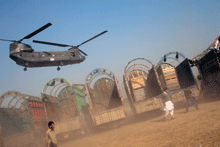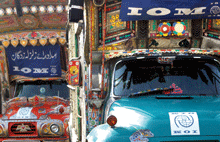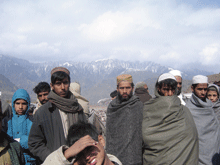IOM AIMS HIGH in Pakistan Earthquake Relief
 On 8 October, an earthquake measuring 7.6 on the Richter scale struck Afghanistan, northern India and Pakistan, the latter the worst hit of the three. In Pakistan, more than 73,000 people were killed, another 70,000 injured and more than 3 million affected. IOM has responded with a six-month emergency humanitarian operation there encompassing the provision of emergency shelter, health assistance and surface transport for the distribution of relief items, and an appeal for US$ 60.5 million to fund these activities.
On 8 October, an earthquake measuring 7.6 on the Richter scale struck Afghanistan, northern India and Pakistan, the latter the worst hit of the three. In Pakistan, more than 73,000 people were killed, another 70,000 injured and more than 3 million affected. IOM has responded with a six-month emergency humanitarian operation there encompassing the provision of emergency shelter, health assistance and surface transport for the distribution of relief items, and an appeal for US$ 60.5 million to fund these activities.
In the earthquake-shattered high valleys of Pakistan-administered Kashmir and North-West Frontier Province, IOM teams have a double role – coordinating the emergency shelter relief efforts of other agencies and delivering the tents and shelter repair kits that will help homeless fam-ilies survive the Himalayan winter.
“We start high and work down. Our priorities in descending order are getting emergency shelter materials to people in inaccessible valleys above 5,000 ft., delivering tents to people at lower altitudes, providing warm clothing and blankets, and winterizing non-winterized tents already distributed by improving their insulation,” says IOM head of operations, Steven Lennon.

One month into the operation, international agencies and the Pakistan government are struggling to meet the logistical equivalent of a perfect storm – the challenge of delivering relief to remote high altitude villages cut off by landslides and expecting heavy snowfalls by early December.
Despite intensive road clearing efforts by the Pakistan military, helicopters are now central to the relief oper-ation. But in an operation that has received only 15 per cent of US$ 550 million UN Flash Appeal, the huge cost of keeping them airborne means that their deployment is continually under threat.
With snow already capping the high peaks, inter-agency coordination that establishes which humanitarian agency is delivering what, where and to whom has become a crucial element in the race to deliver the right aid to the right people in the right locations. For that reason, “clusters” have been formed for each sector including emergency shelter, health, water and sanitation and logistics, each with a lead agency, and which gather all those working in any one field so that information can be shared and oper-ations coordinated.
“As the lead agency of the Emergency Shelter Cluster, our job is to get accurate data from the field, collate it and disseminate it at high speed so it can be used equally by agencies on the ground and government policy-makers,” says IOM Regional Representative in Pakistan, Hassan Abdel Moneim Mostafa.
While IOM cluster coordinators in Islamabad, Muzaffarabad, Mansehra, Bagh, Balakot and Batagram, including staff seconded from the UK Department for International Development (DFID) and the International Federation of Red Cross and Red Crescent Societies (IFRC), crunch the numbers and advise the government and donors, IOM operations staff use their output to target IOM interventions.
“From the outset we focused on relatively inaccessible areas not yet reached by other agencies or the military – initially Allai in Batagram district and Haveli in Bagh. We’re now also focusing on the Neelum valley out of Muzaffarabad and the Kaghan valley out of Balakot,“ explains Steven Lennon.
IOM moved into Haveli, a remote sub-division of Bagh district close to the Line of Control dividing Pakistani and Indian-administered Kashmir, with partner agency Islamic Relief to distribute 500 ten-person arch tents, 500 heaters, 500 mattresses, 5,000 blankets and 120 camp beds donated by the Dutch military.
The equipment, which was flown into Islamabad’s Chaklala airbase from Afghanistan aboard giant Antonov cargo planes, was loaded onto IOM trucks and moved to a Pakistan army base in the town of Forward Kahuta.
British airforce Chinook helicopters coordinated by the UN Joint Logistics Cell (UNJLC) then airlifted the 200 kg tents from the base to a military helipad on the Haji Pir pass at just over 5,000 ft. for distribution in villages in the Bedhi and Mota valleys.
“People in the valleys on the far side of the pass had no help up to that point and snow cuts road access to the area until April,” says Islamic Relief field coordinator, Arshad Rashid, who organized food distributions in the area before the earthquake.
Islamic Relief and IOM four-wheel drive jeeps picked up the tents from the Haji Pir helipad to move them as close as they could to the rubble-strewn villages in the valleys. In the villages, they were distributed to homeless families previously identified by Islamic Relief and the Pakistan military.
But the complex logistics behind the Haveli operation seem almost tame compared with the ongoing Oper-ation Winter Race – a programme that airlifts small IOM, Islamic Relief and IFRC teams by helicopter into isolated villages to assess earthquake damage and deliver shelter repair kits to homeless families.
The programme, which is focused on the Neelum valley close to Muzaffarabad, uses self-sufficient five-person teams supported by helicopters coordinated by UNJLC and UN Humanitarian Air Services (UNHAS).

The teams, which include men, women and shelter construction specialists, go house to house to assess damage and identify vulnerable people. They then use satellite phones to call in helicopter airlifts of shelter repair kits.
Items in the locally procured kits, which are stockpiled in forward bases at Muzaffarabad and Batagram, include corrugated galvanized iron sheeting, plastic sheeting, hammers, nails, pickaxes, saws, wire, buckets, and other items essential for salvaging the remains of houses and building “a warm room” for each family to survive the winter.
“We start by finding the most vulner-able people in the village and building them a shelter. That gets everyone’s attention and then we get them working on shelters for everyone. This is about giving them the materials and the skills, but mostly about motivating them to help themselves,” says IOM team member, Brett Williams.
IOM, which has ordered 10,000 of the kits, the last of which is scheduled for delivery on 25 November, has asked partner agencies in the Emergency Shelter Cluster to contribute materials and staff to the programme. Three engineering battalions of the Pakistan army assigned to earthquake relief will provide support to Winter Race and UNHCR has already made a significant contribution of material.
“Winter Race is a window of opportunity that offers people in valleys above 5,000 ft. an improvised alternative that may be preferable to tents in deep snow. We know that many people don’t want to come down to camps at lower altitudes and we think that this could be the solution to minimizing displacement and all the problems associated with it,” says Lennon.
But with the weather in the mountains expected to deteriorate daily, nobody is under any illusion that the logistical challenge facing IOM and other agencies will become progressively worse through November and into December. Rain and snow will reduce the number of helicopter sorties and may bring down more landslides, blocking more roads.
The other major challenge, similar to other organizations, is the lack of funds needed to keep working on getting help to those who, without it, will probably not survive the Himalayan winter. •


